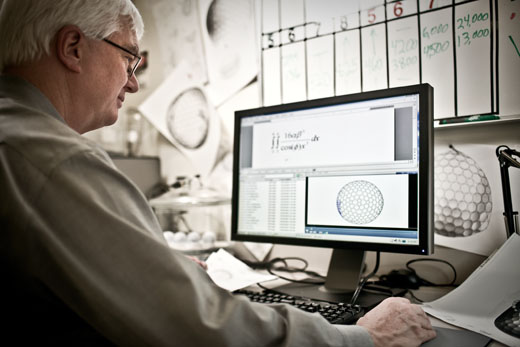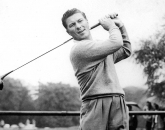 The Pro V1 is seen as a tour ball, a ball that's played by extremely good golfers. But you'd argue that it's just as well suited to the average golfer...
The Pro V1 is seen as a tour ball, a ball that's played by extremely good golfers. But you'd argue that it's just as well suited to the average golfer...
I'll tell you a story. Back in the early 1990s I was playing golf with a friend of mine who was driver obsessed. This was in the days of the balata and the two-piece ball. We were both playing with the Titleist HVC. An older gentleman walks up to us on the tee and asks if he can join us. He's playing a balata ball ¬– and we're like, "Dude, are you kidding me?" Anyway, we hit off and I go right into the hay and my buddy goes left; the old guy hits it down the middle, around 180 yards. As I'm looking for my ball the old guy hits up short of the green, while my buddy goes through the back. I find mine and hack it up. The old guy then pitches to a couple of feet; my buddy and I both chip on and two-putt for bogeys, while he makes a par. Same thing happened on the next hole... and then the next hole. I said to him, "You know, you could hit this two-piece ball and it would give you much greater distance." He said, "Why would I do that? I don't care about distance. I need this soft balata ball for my third shot to keep it as close to the pin as possible." That's what I realized. His score wasn't determined by his tee shot, but it's that all important shot into the green – whether it's a second or third shot. It's all about finding the shot that helps golfers control their score on the hole. That's what the Pro V1 and its soft urethane cover gives all standards of golfer.
What ball do you use – and why?
I have been playing the Pro V1x for quite some time, because as a taller, crazy guy that swings far harder than he should I put too much spin on the ball. That's why I chose the Pro V1x, the lower spinning version, to keep me out of a little more trouble. As I get older, slower and wiser I now use the Pro V1. I don't swing as hard but I hit it every bit as far and generate less spin. I play what I call 'Old Guy Golf'. The Pro V1 gives me a little more control into and around the greens.
The Pro V1 for 2011 spins more than the 2009 version. Is that a direct result of the groove change that has been implemented on tour?
No – maybe yes, but really it's no. We started our groove research years ago. Our club group and our ball group studied it independently of each other and we reached the same conclusion: most of the time the groove change doesn't matter. From the fairway it's the same. But as weather conditions deteriorate, it's different. If you're playing from deep, wet rough you lose up to 30 percent of spin, which is a lot. But how often do you have to hit that shot in tournament golf? We analyzed the statistics and discovered only about seven per cent of shots had the potential to be affected. But if you change the golf ball you're changing it for every shot. How much spin can you put back into the ball? Well, not 30 per cent certainly. That's a crazy number. So changing the ball for that seven per cent of the time isn't worth it. In 2010 we made an experimental Pro V1 with approximately 10 per cent more spin and offered it to tour players. Everyone who tried it dropped it. The pros, who used to control the ball in that situation with spin have learned to control it with trajectory. But the 2011 Pro V1 does have a bit more spin because so many factors in the game – club design, for example – have taken the spin away. It didn't have anything to do with the groove change.
How different is the Pro V1 from 2000, when you first launched the ball, from the brand-new 2011 edition which has just become available?
Radically different. It’s funny, I pulled some of the 2000 version out for our 10th anniversary party but couldn't bring myself to show them around to people. I thought, "urgh, these are ugly" – and compared to the new balls they are. They wouldn't even pass the quality standards that we have in place for the 2011 ball. The materials have changed, we have a new dimple design, a new core technology. Today's ball looks completely different on both the outside and the inside. The original Pro V1 was the best ball for that time, but now the product is much better. It's changed simply because golfers and their equipment have changed.
Have you ever thought of changing the name of the Pro V1?
Several times. When we started we didn't have a name for the ball – not a proper one anyway; we called it the 'Veneer'. At the time we already had 13 balls in the market – the Professional, the HP Tour, the HP Distance and so on. We wanted to make a distance ball with a layer – or veneer – of Urethane and we had trouble deciding where it would fit among the range. Back then we were even making Cobra golf balls, and it was even suggested that we call it the Cobra Tour. Anyway, debate ran for the better part of a year and finally, as we were coming up to the USGA and R&A deadline, I decided to just make up a name – although I thought it would only be a temporary measure. The 'Pro' comes from Professional, the 'V' is for veneer and '1' because it was the first. We gave it to the pros and told them it was just a lab name and that we were going to change it, but they said they liked it, so we kept it for that year. We discussed naming the next version the Pro V2, but the results from focus groups was overwhelmingly for Pro V1. "We love the name, don't change it," was basically what they told us.
What do you think when people like Jack Nicklaus come out and say that the ball needs to be changed, that it goes too far and makes old courses obsolete?
I can assure you that there are articles in golf magazines dating back to 1982 about Nicklaus complaining how far the modern ball goes. This is an old story. How many people shoot all rounds in the 50s? How many times have we seen a score in the 50s? You can count them on one hand. Oh, we're really destroying the game of golf, aren't we? I don't understand what the harm is, what these alarmists are concerned about. Golf equipment, the golf ball, course design, lessons, launch monitors, giant prize money – so many things have contributed to what the game is today. Look at the professional golfer – he's an athlete, he's not the fat kid down the street from 1957. He trains for golf, he eats for golf, he has a sports psychologist. Golf is great entertainment on TV and it's fun to play. What's the problem? Courses are longer, for sure, but they've lengthened the older courses before the Pro V1 came along. The real harm in many cases tends to be that the old courses that were really good places for tournaments now don't have enough parking, space for media, enough space for tents – all the stuff that goes hand in hand with televised tournament golf. We're talking about TV revenue in most cases. I don't entertain any of this business that golf has become ruined by equipment. No one has ever given up the game because it was too easy.
What would you change, if anything, in tournament golf?
How about this? We make the ball in a bunker a problem, not an opportunity. If the pros played the same courses the rest of us play, in the same condition that the rest of us play the scores would go up. Tournament courses are groomed for low scoring – long drives, beautiful lies in bunkers: that's what tournament golf is all about. Nobody else plays courses like that.
We all know about counterfeit golf clubs but are counterfeit golf balls an issue?
Yes, it's a growing issue. We're seeing more of it, and it's ugly. We get golfers who call us up saying 'I bought these balls online, can you check them out?' Well, we don't sell balls online and always advise people to buy from a reputable source, from your local pro shop for example. The examples I've seen – the refurbished balls – are plain ugly. They're taking old golf balls, often cracked inside, grinding off all the covers, including the dimples, adding a new shell of material on the outside and stamping 'Pro V1' on them. They're awful.
Do golf balls have a shelf life?
It depends on the shelf! But seriously, the modern balls are far more resilient than those of the past. As long as the shelf is located in normal room temperatures and not in an aquarium or next to a heater the ball will be fine. The Pro V1 – and any Titleist ball for that matter – will easily last for a few years if stored correctly.
Finally, what has been the biggest thrill in your career?
Well, I'd prefer to answer that after I've attended the China Golf Show. It's my first time here and I can't wait to get started. But that aside, it was when we first introduced the Pro V1, which was at the Invensys Classic in 2000 [which was won by Billy Andrade, who played with it]. We knew we had a great product but the outpouring of positivity from the pros was something else
Click here to see the published article.











